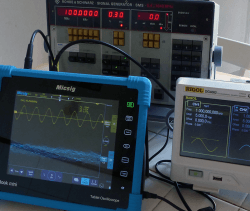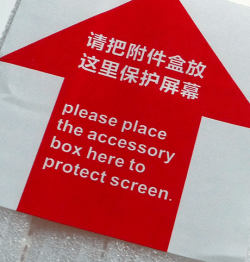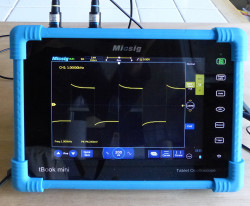Review: Micsig TO1102 Tablet-scope
on
“THAT’s an oscilloscope? Naaaah….”
After the initial surprise, go back and look at the evidence. It IS one.
Unpacking

While taking the oscilloscope from the box, I knew that it looked like a tablet. Calling it Tablet Oscilloscope (TO) or tBook mini, doesn’t leave much doubt on this. However, I was impressed by the 8 inch (20 cm) screen, which offers a resolution of 800x600 pixels. The surface actually used is less than this, but the charm is still very real.
More surprises. There are no knobs, neither for input sensitivity nor for timebase! There is a Start pushbutton on the side (ah, something that’s not virtual). It is true that by virtue of being a tablet it shouldn’t have knobs.

Like all flat screens.
A big red label on the polystyrene packing advises the user not to throw away the box and packing, because it will be extra protection for the screen if it has to be repacked. The whole apparatus is thicker than a tablet, but it is more handy than the digital oscilloscopes offered by Tektronix, Rigol or Siglent. This thin form is in part achieved at the cost of using an external power supply; some prefer an all-in-one.
Powering up
Before powering up the device, I checked the box to make sure I have not missed a notice “MUST read before use”. Well done me, because there is one, but no manual. Doesn’t matter, I wouldn’t have read it anyway. (Yes. I know, sometimes you should…) On the advice sheet, a curious alert: “Make sure that the device is grounded if the test signal is greater than 36 V”. What signal are they talking about? Probably the signal being examined, but alas, even the user manual – later downloaded – has nothing on this subject. As the supplied power adapter has an earth pin, I didn’t look further.

On connecting the power, the screen activates immediately to display a large icon of the maker, then it goes to sleep. You have to press the (non-virtual) button to intialise it, happily this is very fast. It is not the measuring screen that then appears, but a start-up page which, by way of several icons, offers access to various functions such as updating the device or reading the user guide…which must first be downloaded. The advantage of this is that it forces the user to get the latest version, which is not a bad idea. On this start-up screen, you notice one icon larger than the others. Labeled Oscilloscope. I give it a finger tap, and a short bip tells me that my action has been noted. Now we can play.


Discussion (0 comments)